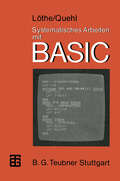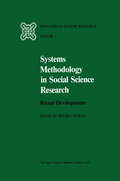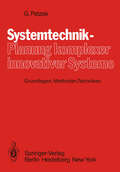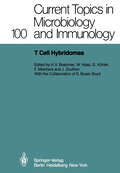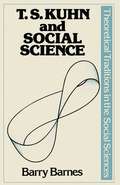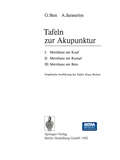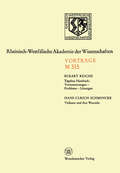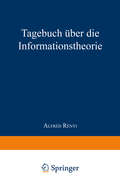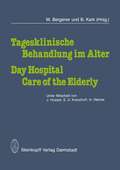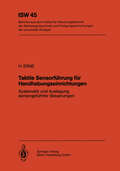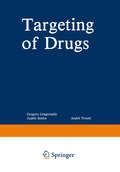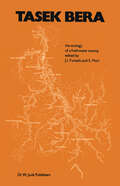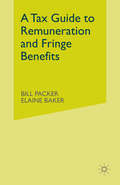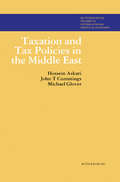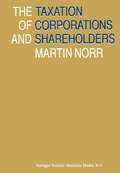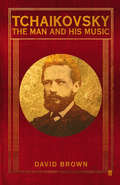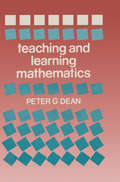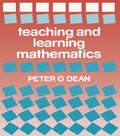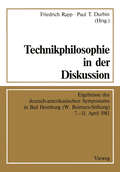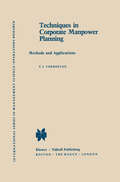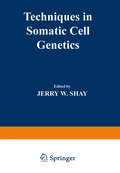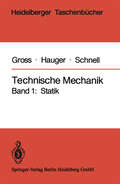- Table View
- List View
Systematisches Arbeiten mit BASIC: Problemlösen — Programmieren
by Werner Quehl Herbert LötheProgrammieren bedeutet nicht nur Beherrschen von Sprache und Pro grammiersystem auf einem konkreten Rechner, sondern auch die Fähig keit, gestellte Probleme zu lösen, und zwar in einer Weise, daß sie von einem Computer bearbeitet werden können. Für dieses computergerechte Lösen von Aufgaben wurden in einer in tensiven Diskussion im Fach Informatik systematische Vorgehenswei sen und geeignete Hilfsmittel entwickelt. Hilfsmittel sind dabei höhere Sprachen, die ein problemnahes Formulieren und Strukturieren von Daten und Befehlsfolgen zulassen. Die Sprache BASIC und das zugehörige Dialogsystem sind Anfang der Sechziger Jahre, also vor dieser Diskussion, entstanden. BASIC un terstützt daher ein systematisches Programmieren nicht, es ermun tert eher zu einem chaotischen Drauflosprogrammieren. Die Vorzüge der Programmiersprache BASIC liegen jedoch darin, daß ihre Anwei sungen mit verhältnismäßig geringem Aufwand in die Maschinenspra che des konkreten Rechners übersetzt oder von diesem interpretiert werden können. Das BASIC-Programmiersystem regt zudem an, im Dialog mit dem Rechner Befehle auszuprobieren und kurze Befehlsfolgen zu testen. Insgesamt ermöglichen also Sprache und System BASIC eine relativ geringe Einstiegsschwelle, um erste Erfahrungen zu machen. Diese Vorzüge haben dazu geführt, daß BASIC bei Mikrocomputern praktisch ausschließlich als grundlegende Sprache verwendet wird. Beim Programmierenlernen mit BASIC tritt nun für den Lehrenden und den Lernenden folgendes Dilemma auf: - Einerseits lassen sich aus methodischen Gründen für die ersten Schritte beim Programmieren nur einfache Programme als Beispiele heranziehen, die auch in BASIC noch überschaubar sind.
Systems Methodology in Social Science Research: Recent Developments (Frontiers in System Research #2)
by R. CavalloFrom the beginning, the systems research movement has shown a high potential for offering a conceptual framework for the understanding of social systems. Much of this potential has been realized, but a major gap remains with regard to operational investigative aids. Developments of the last ten years with a method ological orientation and emphasis seem finally to be filling this gap. The purpose of this book is to describe the most advanced of these developments and to make them available to a wider audience. The emphasis is on developments that are primarily oriented toward interaction with expertise in the social sciences and that thus hold the most promise for social systems investigation. In particu lar, attempts have been made to provide substantiation and illustration of three main points: (1) the common motivation and essential integrability that systems research provides for developments and considerations along a very broad spec trum of interests; (2) the very diverse nature of the types and forms of considera tions that may be meaningfully integrated; and (3) the operational and usable nature that developments in systems methodology represent for research in the social sciences. The book is divided into three parts with a generally increasing degree of specificity. The first part (Chapters 1, 2, and 3) deals with foundational issues associated with modeling and methodology as areas worthy of study in their ix X PREFACE own right.
T Cell Hybridomas: A Workshop at the Basel Institute for Immunology (Current Topics in Microbiology and Immunology #100)
by S. Buser-BoydFor more than ten years cell fusion techniques have been applied in studies on various lymphocyte functions. Ig expression was first studied in hybrids obtained by fusing myeloma cells with fibroblasts (1) or lymphomas (2), both of which do not produce Ig, and with Ig producing myelomas (3) or human blood lymphocytes (4). Kohler and Milstein (5) fused a myeloma with spleen cells from immunized mice. Up to 10% of the hybrids obtained secreted antibodies specific for the immunizing antigen. This suggested that plasma cells preferenti ally fused with the myeloma cells, a finding which was of enormous practical value. It was found that both Band T lymphocytes could be fused with the T cell tumor BW5147, which is however not permissive for Ig synthesis (6). A very large number of T cell hybridomas were generated by fusing BW5147 with cell populations containing in vivo or in vitro activated cells (7). The hybrids showed no specific T cell functions and binding assays for T cell receptors were not available. In particular, no hybrids were obtained which expreS1ed specific cytolytic activity that could be tested in short-term Cr release assays (8). However, the frustrations expressed about these failures, published in January, 1978 (9), were relieved by Taniguchi and Miller's publication a few months later of T cell hybridomas producing antigen-specific suppressor factors (10). Unfortunately, their hybrids rapidly lost factor production.
Tafeln zur Akupunktur: I: Meridiane am Kopf; II: Meridiane am Rumpf; III: Meridiane am Bein
by G. Stux A. JayasuriyaTagebau Hambach: 292. Sitzung am 2. Dezember 1981 in Düsseldorf (Rheinisch-Westfälische Akademie der Wissenschaften #315)
by Eckart ReicheTagesklinische Behandlung im Alter / Day Hospital Care of the Elderly
by J. Husser E. U. Kranzhoff H. WernerTaktile Sensorführung für Handhabungseinrichtungen: Systematik und Auslegung sensorgeführter Steuerungen (ISW Forschung und Praxis #45)
by H. ErneTargeting of Drugs (Nato Science Series A: #47)
by Gregory GregoriadisSuccessful drug use in biology and medicine is often prejudiced by the failure of drugs that are otherwise active in vitro to act as efficiently in vivo. This is because in the living animal drugs must, as a rule, bypass or traverse organs, membranes, cells and molecules that stand between the site of administration and the site of action. In practice, however, drugs can be toxic to normal tissues, have limited or no access to the target and be prematurely excreted or inactivated. There is now growing optimism that such problems may be resolved by the use of carrier systems that will not only protect the non-target environment from the drugs they carry but also deliver them to where they are needed or facilitate their release there. Carrier systems presently under investigation include antibodies, glycoproteins, cells, reconstituted viruses and liposomes. Recent advances in the chemistry of cell receptor and receptor-recognising molecules, llnmunology, and natural and artificial membranes have revealed a multitude of ways in which such carrier systems can be modified or improved upon.
Tasek Bera: The Ecology of a Freshwater Swamp (Monographiae Biologicae #47)
by J. I. Furtado Shuichi MoriJ. I. Furtado and S. Mori This volume, 'Tasek Bera, the ecology of a tropical freshwater swamp', is a monograph based on research at Tasek Bera, under the auspices of the International Biological Programme (lBP) involving Japanese and Malaysian scientists under the sponsorship of the Malaysian National Committee for the IBP (MNC-IBP) which was initiated by the Malaysian Scientific Association (MSA). This collaboration was initiated by one of us (S. Mori) in 1966 at the Scientific Committee for Freshwater Productivity (PF) of the International Biological Programme (SCIBP) of the International Council of Scientific Unions (lCSU). It involved discussions between the Japanese National Com mittee for the IBP (JIBP) and the Malaysian National Committee for the IBP (MNC-IBP) and their respe
Taurine in Nutrition and Neurology (Advances in Experimental Medicine and Biology #139)
by Ryan J. HuxtableTaxation and Tax Policies in the Middle East: Butterworths Studies in International Political Economy
by Hossein Askari John Thomas Cummings Michael GloverTaxation and Tax Policies in the Middle East evaluates the general role that tax policies have played in the economic development of the Middle East since 1945 and proposes some recommendations on how fiscal tools could be better used to promote further advancement in this region.This book is divided into six parts. Part I contains the purpose and outline of the study, while Part II discusses the economic aspects of the major categories of taxes used in most developing countries. The fiscal history and categorical breakdown of the tax profiles of 16 Middle Eastern countries are reviewed in Part III. Part IV analyzes the literature on econometric models that explain differences among countries in tax effort. In Part V, the differences in relative tax efforts across 16 countries with considerations in Islamic history, culture, and natural resource endowment are elaborated. The last part summarizes the entire study.This publication is a good reference for economists and specialists concerned with the taxation and tax policies in the Middle East.
The Taxation of Corporations and Shareholders
by Martin NorrThis monograph is principally the work of the late Martin Norr. He completed a draft of the entire monograph but had not yet revised it when he died in late 1972. At that time, the integration of corporate and shareholder taxation was just beginning to become of widespread interest in the United States. With the increasing interest thereafter, the International Tax Program began to revise his manuscript, making as few changes as possible in the original draft. We had the benefit of criticism and analysis from Professor Richard M. Bird of the University of Toronto, now Director of the Institute of Policy Analysis there. In addition, Mr. Mitsuo Sato of the Ministry of Finance in Japan gave freely of his time in carefully suggesting changes throughout the manuscript. The present version of Chapter 3 owes a great deal to his additions and suggestions. Thanks are also due to Professor Hugh J. Ault of Boston College Law School for the Appendix, containing his description of the German integration system that became effective in 1977, which was first published in Law & Policy in International Business. Mr. Norr's interest in the subject of corporate and shareholder taxation developed while he was writing the International Tax Program's World Tax Series volume Taxation in France, published in 1966. The integration of French taxes on corporations and shareholders took place just after that volume was finished, but had been under discussion in France for some time before then.
Tchaikovsky: The Man and his Music
by Prof. David BrownThis volume uniquely combines a lively biography of one of the best-loved composers of the nineteenth century with a detailed chronological guide to much of his oeuvre, from the most popular - Swan Lake or the 1812 Overture - to the lesser known pieces. David Brown enthusiastically and sensitively guides the reader through Tchaikovsky's music in the context of his life. His writing on the music is accessible and informative, both for the professional musician and the keen amateur listener. The biographical writing includes fascinating quotations from the composer's letters, and those of his friends; the Tchaikovsky that emerges is, despite his periodic struggle with depression, a man with a positive attitude to life, and a kind and supportive friend to many around him. This is essential reading for anyone with an interest in Tchaikovsky, his music, or the culture of the time.'One of the finest one-volume biographies to have appeared in recent years, written with such insight that it feels as though one is on a hot-line to the composer himself . . . by the end I felt I knew Tchaikovsky so much better. A classic.' Classic FM Magazine'I can't imagine a more intelligently sympathetic treatment of the man and his music.' BBC Music Magazine
Teaching and Learning Mathematics
by Peter G. DeanSchool mathematics is a complex subject and an ever-changing topic, but this book will help teachers, parents and employers to understand it better.
Teaching and Learning Mathematics
by Peter G. DeanSchool mathematics is a complex subject and an ever-changing topic, but this book will help teachers, parents and employers to understand it better.
Teaching Maths
by D. M. NealSchool mathematics is a complex subject and an ever-changing topic, but this book will help teachers, parents and employers to understand it better.
Teaching Maths
by D. M. NealSchool mathematics is a complex subject and an ever-changing topic, but this book will help teachers, parents and employers to understand it better.
Technikphilosophie in der Diskussion: Ergebnisse des deutsch-amerikanischen Symposiums in Bad Homburg (W. Reimers-Stiftung) 7.–11. April 1981
by Friedrich Rapp Paul T. DurbinTechniques in Corporate Manpower Planning: Methods and Applications (International Series in Management Science Operations Research)
by C.J. VerhoevenThe title of this book is Techniques in Corporate Manpower Planning: Methods and Applications. Manpower planning, also called personnel plan ning, implies the analysis of possible discrepancies in the future between personnel demand and supply. Personnel demand will also be called person nel requirement; and personnel supply, personnel availability. The notion of corporate manpower planning refers to the planning of personnel on the level of an industrial or governmental organization. As such, it does not stand for manpower planning for branches of industries or labor market studies of countries or international communities. One type of manpower planning is the planning of short-term succes sions of managers or the assignment planning of positions for individual employees for the next year. In fact, this type of short-term manpower plan ning is always executed, whether formally or informally, centrally or other wise. Another type of manpower planning, however, may be executed to match the requirement for and availability of personnel for the medium and long term. This type of manpower planning considers groups of employees rather than individuals. Our goal is to consider medium- and long-term manpower planning for groups of employees. We call this the multicategory vii Vlll PREFACE approach to manpower planning. In our view, this medium-and long-term personnel planning provides the conditions for individual manpower plan ning or for personnel development.
Techniques in Somatic Cell Genetics
by Jerry W. ShaySomatic cell genetics is an exciting and rapidly expanding field of research. Since descriptions of the major experimental techniques in the field are scattered throughout various journals and other publications, there is a real need for a single reference source for both established investigators and students in the field. In addition, technical reports are frequently abridged such that many researchers are discouraged from attempting to adopt the appropriate methodology. This book, therefore, describes in detail the many recent technical advances in such areas of somatic cell genetics as transfer mediated by liposomes, erythrocyte ghosts, chromosomes, micro cells, mito chondria, and isolated nuclear DNA. These techniques have increased our understanding of the organization and regulation of eukaryotic cells. The production of antibiotic-resistant cell lines and their use in studying cytoplasmic inheritance are also included. Evidence for the cytoplasmic regulation of nuclear gene expression in eukaryotic cells is rapidly accumu lating following the characterization of cytoplasmic mutations. The produc tion of nuclear-coded mutations, their use in standard cell hybridization, and recent advances in techniques for fusing whole cells or cell components are also described.
Technische Mechanik: Band 1: Statik (Heidelberger Taschenbücher #215)
by D. Gross W. Hauger W. SchnellDie Statik stellt den ersten Teil eines dreibändigen Lehrbuches der Technischen Mechanik dar. Sie wird gefolgt von der Elastostatik und der Kinetik. Ziel des Buches ist es, an das Verstehen der wesentlichen Grund gesetze und Methoden der Mechanik heranzuführen. Auch soll es zur Entwicklung der Fähigkeit beitragen, mit Hilfe der Mechanik Ingenieurprobleme zu formulieren und selbständig zu lösen. Das Buch ist aus Lehrveranstaltungen hervorgegangen, die von den Verfassern für Ingenieur~Studenten aller Fachrichtungen gehal ten wurden. Der dargestellte Stoff orientiert sich im Umfang an den Mechanik-Kursen deutschsprachiger Hochschulen. Bei Beschrän kung auf das unumgänglich Notwendige wurde bewußt so manches wünschenswerte Detail einer ausführlicheren Darstellung des Grundlegenden geopfert. Ohne unpräzise zu sein, haben wir uns um einen möglichst einfachen Zugang zur Mechanik bemüht, der den unterschiedlichen Eingangskenntnissen der heutigen Studienanfan ger gerecht wird. Uns kam es vor allem darauf an, ein tragfähiges Fundament zu legen, das in den Ingenieurfachern genutzt werden kann und das ein tieferes Eindringen in weitergehende Gebiete der Mechanik ermöglicht. Die Mechanik ist nicht durch reine Lektüre erlernbar. Dieses Buch sollte deshalb als echtes Arbeitsmittel verwendet werden. Der Leser muß sich schon die Mühe machen, mit Bleistift und Papier die eine oder andere Herleitung nachzuvollziehen. Vor allem kann die Anwendung der scheinbar so leichten Gesetzmäßigkeiten nur durch selbständiges Lösen von Aufgaben gelernt werden. Diesem Zweck dienen auch die durchgerechneten Beispiele. Herzlich gedankt sei an dieser Stelle Frau I. Melzer und Frau G. Otto, die geduldig die verschiedenen Manuskriptfassungen ange fertigt haben.
